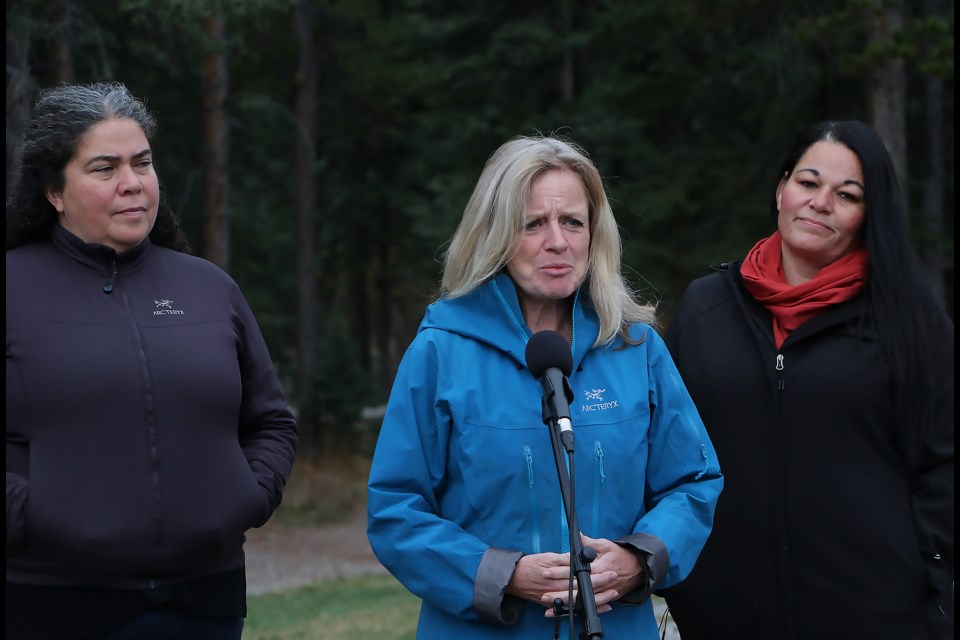CANMORE – Official opposition leader Rachel Notley, joined by NDP MLAs Sarah Elmeligi and Jodi Calahoo Stonehouse, used Canmore – once known as a mining town and now for its visitor economy – as the stage to renew a call to Alberta’s government to axe coal mining in the eastern slopes Friday (Oct. 13).
The mountain town’s coal mining history dates back to 1883, but since its last operations ceased in 1979, it has become more synonymous with tourism.
Elmeligi, MLA for Banff-Kananaskis and opposition critic for tourism, sport and recreation, used Canmore as a case study for nullifying the coal industry in the Rocky Mountains.
“Over the last 40 years, we’ve been developing this incredible tourism offer here in Canmore and as a community, we’ve really benefitted from that,” she said. “Tourism has created all kinds of positive ramifications for our community, from good places to eat to lots of live music and shows to participate in, and [it has created] a really cool culture in our community.”
The call to block all drilling in the eastern slopes comes after a controversial proposal to bore holes and explore for coal in the Grassy Mountain area recently resurfaced from Australian company Northback Holdings – formerly Benga Mining.
The application was met with public outcry and rejected by provincial and federal regulators in 2021, and the province, in addition to the Alberta Energy Regulator, is being criticized for allowing it to come forward once more.
“It is time for [Premier] Danielle Smith and [Minister of Energy and Minerals] Brian Jean to unequivocally state that no drilling and no mining will be allowed in the Eastern Slopes,” said Notley at the Canmore press conference, held at the Larch outdoor ice rink.
“Rather than protect the area’s significant role in the environmental health of our province and our watersheds and the important role the Rockies play in Alberta’s economy, Danielle Smith has no problem making exceptions to allow companies to slice into these mountains, permanently destroying them.”
The cost to the environment – particularly to the health of waterways – far outweighs the economic benefit the industry provides, argued Elmeligi, a longtime conservation biologist in the Bow Valley.
“We don’t want to go back to the coal mining economy of the past. One that causes permanent harm to our natural spaces while producing only modest and temporary economic returns,” she said.
Mining the eastern slopes is at odds with the Alberta government’s plan to grow its tourism economy to more than $20 billion by 2035, she added. The goal focuses on the development and maintenance of 10 zones across the province, including the Crowsnest Pass, where Grassy Mountain is being proposed.
While supporting a visitor economy comes with its own set of challenges, Canmore – along with Banff and Jasper, which also once supported coal operations in the area – have since become an anchor to the tourism industry in the province with no signs of slowing down, unlike the historic boom-and-bust cycle of coal.
According to a December 2022 report by Verum Consulting, the towns generate $112 million in provincial taxes annually and contribute $2.3 billion to provincial GDP.
Conversely, in the 2019-2020 fiscal year, coal represented $11.8 million or 0.2 per cent of all of Alberta’s total non-renewable resource revenue of $5.9 billion, according to the province.
The coal industry provided crucial support to numerous communities in southern Alberta for an extended period and thrived well into the 20th century, but as the 1970s arrived, demand for coal began to decline and the three mountain towns weren’t the only communities in Alberta forced to diversify.
Drumheller, formerly one of the largest coal producers in Western Canada, also closed its last coal operation – the Atlas Coal Mine – in 1979. The area, once defined by an energy-based economy, is now synonymous with dinosaurs and has become internationally known for its rich fossil deposits, much of it showcased at the Royal Tyrell Museum of Palaeontology, which reported 500,000 visitors in 2022.
Dinosaurs are to Drumheller what the 1988 Winter Olympics was to Canmore, bringing new economic opportunities to areas once reliant on coal.
Elmeligi believes the Bow Valley, which counts more than four million visitors to Banff National Park and Kananaskis Country each year, can be a leader to other communities in the province in generating more sustainable economies through tourism.
“I really look forward in this [tourism] critic role to helping to work with other rural communities looking to develop their tourism offer and sharing some of the lessons that we’ve learned here so that we know as tourism develops, it’s in alignment with community perspectives and needs and it actually enhances community value and cultural recognition,” she said.
The NDP has pledged to protect the Rocky Mountains by law through the Eastern Slopes Protection Act, which would ban coal mining in the Rockies and surrounding areas, but the bill has yet to be endorsed by the UCP.
The Outlook reached out to the Ministry of Energy and Minerals but a spokesperson was not immediately available for comment.
The Local Journalism Initiative is funded by the Government of Canada. The position covers Îyârhe (Stoney) Nakoda First Nation and Kananaskis Country.




